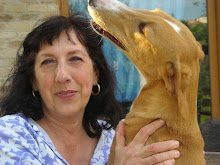venerdì 30 maggio 2014
giovedì 29 maggio 2014
martedì 27 maggio 2014
Finalmente!!!
Couto Veterinary ConsultantsConsultation and education in veterinary and comparative oncology, hematology, clinical pathology, and sighthound medicine.
Home Español For Veterinarians For Owners/Adopters Scooby Animal Shelter Photo Album Blog Site Map
Are Sighthounds Really Dogs?
Blog The Greyhound Health Initiative™ »
The dog was domesticated approximately 14,000 years ago. Due to both natural and human selection, there are now over 400 morphologically distinct breeds; these breeds are included within groups (per the American Kennel Club). The AKC Hound group is composed of over 25 breeds, and includes the sighthounds, dogs that pursue their prey by keeping it in sight. All sighthounds have similar phenotype; they are slender, dolichocephalic, agile, and fast. There are over 15 recognized breeds in this group, including the Afghan Hound, Azawakh, Borzoi, Chart Polski, Galgo Español, Greyhound, Hortaya Borzaya, Irish Wolfhound, Italian Greyhound, Magyar Agar, Saluki, Scottish Deerhound, Sloughi, Whippet, and Rajapalayam. Although one tends to think of sighthounds as “sprinters”, several of the breeds are indeed “endurance” runners (e.g.; Galgo Español).
There are fossil records and paintings of sighthound-looking dogs dating back to 7,000-6,000 BC. In other words, this group has evolved quite tightly during several thousand years. Recent genetic work suggests that Greyhounds have unique genomic features that are different from those in other breeds. Anybody who has owned or worked with Greyhound patients knows how different they are from dogs of other breeds. Most sighthounds share similar biological features.
It is estimated that over 200,000 Greyhounds live in homes as pets in the US and Canada, compared to 35,000 Greyhounds in racetracks. In the past few years, private Greyhound adoptions ranged from 15,000 to 18,000/year; there is also a large ongoing effort of Galgo and Irish Greyhound adoptions in Europe.
EoGransHarperCroppedEoNoGranBurgerCropped
Therefore, it is important to recognize the physiological peculiarities of this breed. From the hematologic standpoint, these athletic dogs have more red blood cells than other dogs; hence, higher packed cell volume (PCV) and hematocrit (HCT), hemoglobin concentration, red blood cell count, and whole blood viscosity than other dogs. A healthy Greyhound has a HCT of 50-63%, something than in a dog of any other breed will result in a presumptive diagnosis of polycythemia or erythrocytosis. The white blood cell (WBC), neutrophil (WBCs that fight bacteria), and platelet (blood cells that start blood clotting) counts are lower in Greyhounds than in other breeds. Most normal Greyhounds have WBC of 3-5X109/L, with neutrophil counts as low as 1.8X109/L; a typical platelet count in a healthy Greyhound is 80-120 X109/L2. In addition, Greyhound eosinophils (cell involved in allergic and parasitic reactions) lack the characteristic orange granules seen in all other breeds (top); the granules do not stain, thus resulting in the appearance of cytoplasmic vacuoles. These “vacuolated cells with bilobed nuclei” (bottom) can frequently be confused with toxic bands (a sign of severe inflammation/infection).
The serum biochemical profiles in Greyhounds also have values that are typically outside the reference rage for dogs. Mainly, the serum creatinine (marker of kidney function) concentrations are high (1-2.2 mg/dL), and the total serum protein (5-6 gm/dL) and globulin (1.8-2.5 gm/dL) concentrations are lower than in other dogs; low serum acute phase protein concentrations account for the lower globulin concentration. Depending on the instrument used, other values may also be outside the reference range for dogs. We recently demonstrated that serum calcium (both total and ionized) and magnesium are lower than in no-Greyhound dogs. The results of venous or arterial blood gas analysis and cooximetry in Greyhounds also yields results outside the reference range for dogs.
Greyhounds also have unique blood types; between 50 and 70% of the Greyhounds are “universal” blood donors (negative for DEA 1.1, 1.2, and 7), compared to <20 1.1="" 87="" administration="" adulthood="" and="" are="" as="" attributed="" been="" blood="" breeds.="" card="" coexisting="" compared="" concentration="" concentrations="" days="" dea="" disorders="" dog="" dogs="" donors="" early="" etc="" for="" greyhounds="" has="" have="" hormone="" however="" in="" independently="" into="" it="" known="" low="" lower="" most="" non-greyhound="" normal="" not.="" of="" only="" or="" other="" persist="" pre-training="" present="" qualify="" race="" racing="" serum="" stress="" t4="" testosterone="" than="" that="" the="" they="" thyroid="" thyroxine="" to="" typing="" using="" various="" was="" well="" when="" whether="" would="" years="" young="">90%) have T4 values below the reference range for the breed, and are commonly diagnosed as “hypothyroid”7. A variable proportion of Greyhounds (10-30%) also have lower free T4 (fT4) concentrations than non-Greyhounds. However, all these Greyhounds have normal TSH concentrations and are therefore NOT HYPOTHYROID. A recent study used thyroid scintigraphy to demonstrate that Greyhounds with low serum T4 are actually euthyroid.
From the cardiovascular standpoint, normal Greyhounds typically have a 1-2/6 left-sided basilar systolic murmur (abnormal heart sound caused by turbulent blood flow or swirling) that irradiates into the carotid artery (bruit); this murmur is louder when the dog is excited and has higher sympathetic tone. The murmur is due to the fact that they have a very large left ventricle (cardiac chamber that pumps blood to the body), needed to pump highly viscous blood though the contracting muscles during exercise. However, the diameter of the aortic annulus (“exit door” of the left ventricle) is similar to that in dogs of equivalent size, thus resulting in a murmur of functional aortic stenosis due to high aortic velocity. The larger left ventricle in Greyhounds results in a high vertebral heart score (VHS), and an erroneous diagnosis of cardiomegaly on radiographs. Greyhounds also have higher concentrations of serum troponin I and proBNP (biomarkers of heart disease) than other dogs; they are frequently in the range of a dog with cardiomyopathy.
Greyhounds and other sighthounds (except Irish Wolfhounds) also have high blood pressure. In the 60s, several medical research institutions kept Greyhounds as a model for systemic hypertension in people. A normal Greyhound may have systolic BP of >160 mmHg upon presentation to a veterinary hospital. Greyhounds have a “white coat effect” on BP; normal Greyhounds have systolic BPs in the 160 mmHg range in the hospital, but only 120 mmHg at home.
Anybody who uses medication in a Greyhound knows that in this breed, “Life is like a box of chocolates”; in other words, you “never know what you are going to get”. Recent research has shown that Greyhounds do not metabolize drugs as other dogs do. The concentration of hepatic cytochrome P-450 enzymes (CYP) is significantly lower than in other breeds, thus accounting for erratic metabolism of some drugs when polypharmacy is used. For example, a therapeutic dose of propofol in a Greyhound results in anesthesia that lasts minutes; if the dog is receiving a “CYP drug” (drug that “ties up” this enzymatic system), such a chloramphenicol, the same dose of propofol will result in anesthesia lasting several hours. In my experience, a good example of this is the administration of acepromazine. If a Greyhound receives a therapeutic dose of acepromazine (0.05-0.1 mg/kg) for premedication, anesthesia recovery may take as long as 8-12 hours; I use a total dose of 0.5 mg for a 30-kg Greyhound. In addition to the relative CYP deficiency, Greyhounds also have high glomerular filtration rate (GFR) and volume of distribution, and may have differences in intestinal drug---
Finalmente un articolo chiaro, coinciso e ben esposto sulle peculiarità INNEGABILI dei Levrieri, nonostante alcune neoassociazioni che non sanno nemmeno cos'hanno per le mani rifiutino queste differenze e si permettano di criticare chi conosce profondamente i Levrieri!!!
Finalmente un articolo chiaro, coinciso e ben esposto sulle peculiarità INNEGABILI dei Levrieri, nonostante alcune neoassociazioni che non sanno nemmeno cos'hanno per le mani rifiutino queste differenze e si permettano di criticare chi conosce profondamente i Levrieri!!!
lunedì 26 maggio 2014
domenica 25 maggio 2014
giovedì 22 maggio 2014
lunedì 19 maggio 2014
Iscriviti a:
Commenti (Atom)






























































